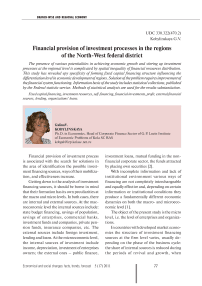The combination of nature protection and neighborhood development: possibility of the model on the kola peninsular
Автор: Ivanova Ludmila Viktorovna
Журнал: Economic and Social Changes: Facts, Trends, Forecast @volnc-esc-en
Рубрика: Environmental economics
Статья в выпуске: 5 (17) т.4, 2011 года.
Бесплатный доступ
The possibility of application of a new Western paradigm as to the specially protected natural territories in the Extreme North of Russia is discussed in the article. It implies the combination of nature protection and neighborhood development. The author writes in brief about the new paradigm and the system of specially protected natural territories in the Murmansk Oblast. There are such problems of specially protected natural territories in the region as conflict of interest between different stakeholders, lack of support from the authorities and weak tourism infrastructure and competence in this sphere. However, the enthusiasm on the subject of local national parks and nature parks and a growing number of tourists allow us to suppose that the role of specially protected natural territories in the neighborhood development will be more significant in future.
Nature protection, new paradigm for specially protected natural territories, neighborhood development, ecological tourism
Короткий адрес: https://sciup.org/147223286
IDR: 147223286 | УДК: 332.1:502.3
Список литературы The combination of nature protection and neighborhood development: possibility of the model on the kola peninsular
- Günter, M. Field Guide to the Protected Areas of the Barents Region: Svanhovd Environmental Centre, Svanvik, 2004.
- Bushell, R., Eagles, P. F. J. Tourism and protected areas: benefits beyond boundaries: The Vth IUCN World Park Congress: CABRI, 2007.
- Murota, T., Glazyrina, I. (2010). Common-Pool resources in East Russia: a case study on the creation of a new national park as a form of community-based natural resource management. Environmental Economics and Policy Studies 11, Pp. 37-52.
- Hünneland, G., Nilssen, F. (2000). Comanagement in Northwest Russian Fisheries. Society and Natural Resources, Pp. 13, 635-648.
- Wilson, E. (2007). Time, idealisation and international development: promoting Canadian co-management in northern Russia. Area, 39(3), Pp. 323-330.
- Odindi, J.O., Ayirebi, G. K. (2010). Communities and conservation: in search for a win-win situation in the great fish river reserve. Journal of Sustainable Development in Africa, 12(1), Pp. 13-26.
- Dearden, P., & Bennet, M. (2005). Trends in Global Protected Area Governance 1992 -2002. Environmental Management, 36(1), Pp. 89-100.
- Eagles, P. F. J. (2004). Tourism at the Fifth World Park Conference, Durban, South Africa, 8-17 September 2003. Journal of Sustainable Tourism, 12(2), Pp. 169-173.
- Font, X., Cochrane, J., Trapper, R. (2004). Tourism for Protected Area Financing: Understanding tourism revenues for effective management plans. Leeds (UK), Leeds Metropolitan University.
- Electronic resourse. -Available at: http://www.murmantourism.ru/
- Nature preserve in Russia. -2010: stat. coll. -Federal State Statistics Service . -Available at: http://www.gks.ru/
- Stepanitskiy, V.B. Ecological tourism on the specially protected natural territories of Russia: problems and prospects/V.B. Stepanitskiy//The text of the report at the International Conference “Innovative Policies for Heritage Safeguarding and Development of Cultural and Educational Tourism”. -M., 2005.
- Shitlmark, F. History of the Russian Zapovedniks 1895 -1995: Russian Nature Press, 2003.
- Basanets, L. Russian Protected Areas as Part of the World Ecotourism System. ECOCLUB.com E-Paper Series, 2002.
- Locke, H., Dearden, P. (2005). Rethinking Protected Areas Categories and the New Paradigm. Environmental Conservation, 32(1), Pp. 1-10.


